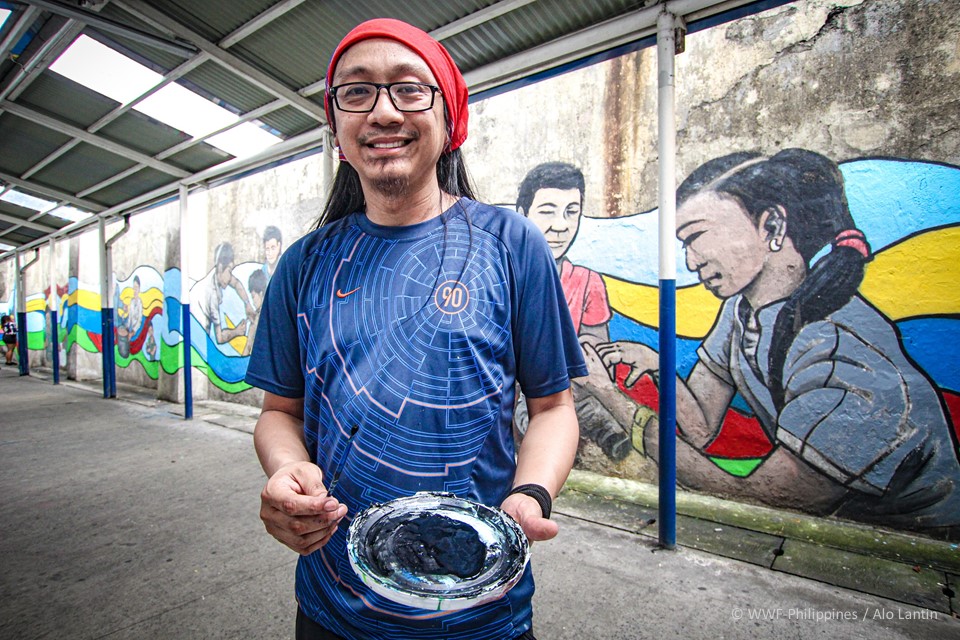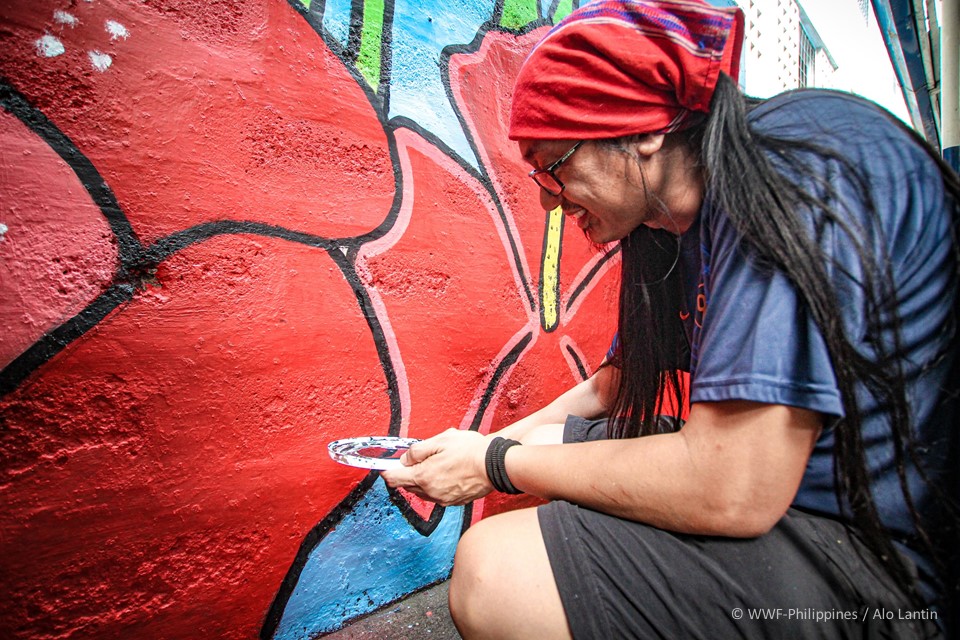The Role of Art in Conservation: Communicating Hope in Desperate Times
November 2019

Artist AG Saño stands before one of his murals outside Adamson University. Both a painter and an outspoken conservationist, Saño does his part as a spokesperson for the environment. Photograph © Alo Lantin / WWF-Philippines
Art comes to the service of life as a painter gives voice to the cause of conservation.
Painter and conservationist AG Saño wields his art as his tool as he works to protect the planet. A renowned artist in the Philippines, Saño even gained more prominence in 2010 when he began painting murals of dolphins on the walls of Metro Manila. He had been moved by a documentary entitled “The Cove,” which features the mass slaughter of dolphins in a bay in Japan and pledged to paint as many as the marine mammals that are being killed each year. He set to work, and soon, people from all across the Philippines had taken to the streets to join in his campaign. Since then he’s continued his mission, plastering paintings depicting environmental issues on public spaces across the country.
Last November he took his talents to the walls of Adamson University.

Saño works on the edges of his latest mural. For Saño, public art is the perfect opportunity to expose new audiences to environmental issues. Photograph © Alo Lantin / WWF-Philippines
Before taking his brush to the streets, Saño was a volunteer researcher for the World Wide Fund for Nature (WWF) Philippines. In the seas surrounding the Babuyan Islands, he helped document humpback whales, an experience that brought him close to nature. He admits, however, that such an experience is not open to all.
“It’s true, not everyone can experience nature first-hand, considering that we have our own daily lives to deal with. What I want to show, though, is that you don’t necessarily need to in order to build a relationship with nature. Anyone can learn to love nature,” he explains. Saño sees his art not just as a way for him to share his passion for the planet with others, but an avenue for people to build their own relationship with the environment.
“The value of art is how it communicates truth to the people. Truth is science and research that can’t be fully appreciated by the public because of its technical language. It’s the creative world that thinks of ways to communicate these truths to the public,” explains Saño. For him, the role of art in conservation work is to help the average person understand scientific concepts that might otherwise be difficult for them to comprehend. He hopes that by exposing people to these issues during their daily commute, the public will come to recognize their importance.
“What’s great about these murals, this static art, is that it doesn’t go anywhere. Think about all the people who will pass by this mural every day. Depending where you put it up, that could be millions of people each year, seeing your message every day, until one day it sinks in,” he adds.
Artists like Saño serve as evangelists for the planet as they win over new minds in the fight for environmental conservation. For those in the sciences, faced with the desperation of today’s issues, this support is a much-needed blessing.

WWF-Philippines National Youth Council Vice-Chairperson Romina Lim adds dots to a mural of a rafflesia. As a marine scientist and a youth leader, Lim recognizes the importance of translating scientific concepts for the average person to understand. Photograph © Alo Lantin / WWF-Philippines
Joining Saño at the walls of Adamson University is World Wide Fund for Nature (WWF) Philippines National Youth Council Vice-Chairperson, Romina Lim. A scientist at the Marine Science Institute of the Philippines, Lim has proactively pushed for ocean conservation through both science and social activism.
“The question, for us scientists, is how can the average person see the value of the work we’re doing? That’s where art comes in. Art is universal. Whether you know science or not, whether you understand Filipino or not, this art helps people to see that nature is beautiful and that these things are important,” explains Lim. As a marine scientist, Lim works with environmental issues on a day-to-day basis and has grown to care deeply for them. For those who don’t have a background in conservation, however, art like the murals of AG Saño is a good way for people to start caring. This is crucial, she believes, now that the human race is faced with problems as tricky as climate change and mass extinction.
“It’s sad to think, but who knows – this could be the only chance many people get to see these animals before they go extinct. So at least people get to see them before they disappear. Maybe then we can keep them from disappearing altogether,” concludes Lim. For both Saño and Lim, art helps to build both passion and hope – both vital resources toward tiding over today’s environmental crisis.

Saño and Lim stand before their work. Their hope is for people to pass by these murals every day and to one day grow to care deeply for the planet. Photograph © Alo Lantin / WWF-Philippines
“I like it when a painting is larger than the person. It reminds us that nature is bigger than all of us. A painting like that speaks volumes,” concludes Saño. As today’s environmental issues grow ever larger, more so does the planet need the support of the public to tide over our most pressing problems. Come stand with WWF-Philippines and help us make the world beautiful as we share our advocacy with the rest of the world.
Contact teampanda@wwf.org.ph if you’d like to volunteer and help share our message of conservation.
For more information, please contact:
Isobel Resurreccion
National Youth Council Coordinator
kfiresurreccion@gmail.com
For media arrangements, please contact:
Pam Luber
Integrated Communications Manager
pluber@wwf.org.ph
